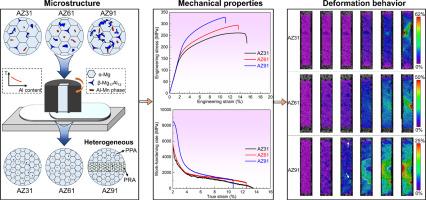固态增材制造Mg-Al-Zn-Mn合金:Al含量对显微组织和力学性能的影响
IF 13.8
1区 材料科学
Q1 METALLURGY & METALLURGICAL ENGINEERING
引用次数: 0
摘要
添加剂搅拌摩擦沉积(AFSD)作为一种先进的固态增材制造技术,在制造大型工程结构部件方面具有巨大的潜力。在本研究中,通过AFSD制备了Mg-xAl-1Zn-0.5Mn (x = 3,6和9 wt. %)合金。并系统研究了Al含量对合金显微组织演变、力学性能和断裂行为的影响。结果表明:所有AFSD AZ系列镁合金均表现出细化的等轴晶粒和典型的基面织构,其(0002)轴平行于晶形方向(BD);随着Al含量的增加,平均晶粒尺寸和基织构强度逐渐减小。Al含量低(≤6 wt. %)的合金表现出均匀的晶粒尺寸和析出相分布,而Al含量高(如9 wt. %)的合金表现出由晶界附近由β-Mg17Al12相装饰的细晶粒带和粗晶粒带组成的双峰结构。因此,观察到明显的强度-塑性权衡:随着Al含量的增加,屈服强度从152.8±17.9 MPa上升到215.5±17.7 MPa,同时断裂伸长率从15.9±0.6 %下降到12.3±0.6 %。这些研究结果可以为具有协同强度和延展性的AFSD AZ系列(Mg-Al-Zn-Mn)合金提供理论见解和实践指导。本文章由计算机程序翻译,如有差异,请以英文原文为准。

Solid-state additively manufactured Mg-Al-Zn-Mn alloys: Effects of Al content on microstructures and mechanical properties
Additive friction stir deposition (AFSD), as an advanced solid-state additive manufacturing technique, offers significant potential for fabricating large-scale engineering structural components. In this study, Mg-xAl-1Zn-0.5Mn (x = 3, 6, and 9 wt. %) alloys were fabricated via AFSD. And the effect of Al content on the microstructural evolution, mechanical properties, and fracture behavior was systematically investigated. The results reveal that all AFSD AZ series Mg alloys exhibit refined equiaxed grains and a typical basal texture, with the (0002) axis parallel to the build direction (BD). However, increasing Al content results in a gradual decrease in both average grain size and basal texture intensity. Alloy with low content of Al (≤ 6 wt. %) exhibits uniform grain size and precipitate distribution, whereas alloy with high content of Al (e.g., 9 wt. %) displays a bimodal structure composed of fine grain bands decorated by β-Mg17Al12 phase near grain boundaries and coarse grain bands. For this, a clear strength-ductility trade-off is observed: with increasing Al content, the yield strength rises from 152.8 ± 17.9 MPa to 215.5 ± 17.7 MPa, accompanied by a reduction in fracture elongation from 15.9 ± 0.6 % to 12.3 ± 0.6 %. These findings can offer theoretical insight and practical guidance for the AFSD AZ series (Mg-Al-Zn-Mn) alloys with synergistic strength and ductility.
求助全文
通过发布文献求助,成功后即可免费获取论文全文。
去求助
来源期刊

Journal of Magnesium and Alloys
Engineering-Mechanics of Materials
CiteScore
20.20
自引率
14.80%
发文量
52
审稿时长
59 days
期刊介绍:
The Journal of Magnesium and Alloys serves as a global platform for both theoretical and experimental studies in magnesium science and engineering. It welcomes submissions investigating various scientific and engineering factors impacting the metallurgy, processing, microstructure, properties, and applications of magnesium and alloys. The journal covers all aspects of magnesium and alloy research, including raw materials, alloy casting, extrusion and deformation, corrosion and surface treatment, joining and machining, simulation and modeling, microstructure evolution and mechanical properties, new alloy development, magnesium-based composites, bio-materials and energy materials, applications, and recycling.
 求助内容:
求助内容: 应助结果提醒方式:
应助结果提醒方式:


